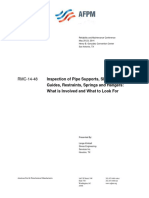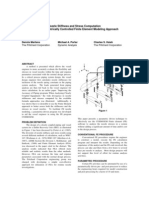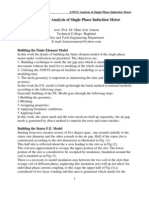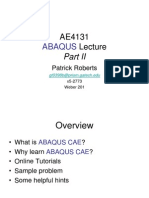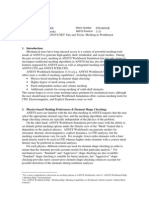Feature Articles: A Publication For ANSYS Users
Feature Articles: A Publication For ANSYS Users
Uploaded by
seansotoCopyright:
Available Formats
Feature Articles: A Publication For ANSYS Users
Feature Articles: A Publication For ANSYS Users
Uploaded by
seansotoOriginal Description:
Original Title
Copyright
Available Formats
Share this document
Did you find this document useful?
Is this content inappropriate?
Copyright:
Available Formats
Feature Articles: A Publication For ANSYS Users
Feature Articles: A Publication For ANSYS Users
Uploaded by
seansotoCopyright:
Available Formats
The Focus - Issue 34
Contents
A Publication for ANSYS Users
Contents
Feature Articles
Hex Meshing Tools
Memory Usage Guidelines for Windows
*TAXIS
On the Web
CFX Enews November 2004
PADT Seminar: CFX Overview
Resources
PADT Support: How can we help?
Upcoming Training at PADT
About The Focus
The Focus Library
Contributor Information
Subscribe / Unsubscribe
Legal Disclaimer
http://www.padtinc.com/epubs/focus/common/contents.asp [3/28/2005 10:22:15 AM]
The Focus - Issue 34
Hex Meshing Tools
A Publication for ANSYS Users
Hex Meshing Tools
by Joe Woodward, PADT
Anyone who has done hex meshing in ANSYS has
learned that complex volumes can be sliced into
simpler sweepable volumes. For example, take a
look at the simple block in Figure 1. With a fillet
and a hole, this volume cannot be directly
hex-meshed. But, we can cut it horizontally to make
two or three sweepable volumes. ANSYS can then
free mesh an area and sweep the mesh though the
volume. Adjacent volumes can be swept in different
directions, resulting in a hex mesh. If you are going
to use LS-Dyna, or some other solver that needs an
all-hex mesh, then it sometimes takes a little extra
work and luck to avoid any wedge elements. With
this method, and sometimes a lot of chopping,
ANSYS can hex mesh just about anything, right?
Well, not exactly.
To continue with the same simple case, Case 1, what happens if the fillet is large enough to touch
the hole (Case 2), or if the hole is tangent to a wall (Case 3)? These are cases that turn up often
when dealing with designers and real geometry. What you get when you try to slice such
geometry is the dreaded topological degeneracy error. You can also get this error when
intersecting slices do not line up correctly, causing sliver volumes. So if youre not careful, all of
your hard work may cause problems of its own. But take heart; if you cant change the geometry,
there are options to get the job done.
The first option is ANSYS Workbench with Design Modeler. In Design Modeler you can slice
the geometry, just as in ANSYS, only more robustly. In Case 2, the hole-fillet tangency, we move
the slice down slightly so that it cuts into the fillet and not tangent to the hole. Even if the same
could have been done in ANSYS Prep7, the resulting volume would not have been sweepable.
There would have been two areas on one side of the volume, and ANSYS will not use
concatenated areas as the source or target for a swept mesh. This is where Workbench has another
advantage.
http://www.padtinc.com/epubs/focus/2005/0034_0120/article1.htm (1 of 6) [3/28/2005 10:25:03 AM]
The Focus - Issue 34
Hex Meshing Tools
A Publication for ANSYS Users
Figure 2
Workbench allows the concatenation of surfaces into virtual cells, which can be used in the
sweeping process. The top of Figure 2 shows the original surfaces and the resulting virtual cell.
The Preview Sweep view highlights all the sweepable volumes in green, as in the bottom of
Figure 2. This is very handy since you can see what needs to be changed before you actually try
to mesh the model.
Figure 3
Now that the volumes are sweepable, it does not mean that they will get meshed with all hexes.
The first time I meshed this geometry, Workbench put wedges in around the hole and nothing that
I tried would get them out. You can specify a mapped mesh on an area, but that did not work
because of the hole. I also tried specifying the element size in the hole, but that still did not
http://www.padtinc.com/epubs/focus/2005/0034_0120/article1.htm (2 of 6) [3/28/2005 10:25:03 AM]
The Focus - Issue 34
Hex Meshing Tools
A Publication for ANSYS Users
change the mesh. I finally had to go back to Design Modeler and increase the distance between
the hole and the slice that I made. The good news here is that Workbench and Design Modeler are
parametric and fully integrated. I just changed the parameter for the slice location, and the
simulation updated with a new all-hex mesh.
Another option for hex-meshing stubborn geometry is ANSYS AI*Environment.
AI*Environment, which was originally ICEM CFD, gives you exact control when hex meshing.
Instead of slicing the geometry, the user slices, stretches, and morphs a blocking topology that
gets projected onto the geometry. The nodes are then projected onto the surfaces and curves of
the geometry. Your geometry does not need to be as clean as with other meshers. Gaps and
overhangs in the surfaces are ignored as long as the nodes can be projected to avoid the problems.
This also limits the amount of defeaturing necessary since the user controls the nodal projections
and can choose not to project to certain features.
Figure 4
Figure 5
Figure 4 shows the final blocking structure for the first geometry case. This structure took four
slices and two special features called O-grids. The X-shaped cuts around the hole are created with
a single O-grid command, and allow the mesh to be perpendicular around the hole. The second
O-grid follows the L-shape of the block, and creates orthogonal elements along the fillet. The
element sizes can be taken from the geometry, or controlled specifically on each edge of the
blocks. The structured mesh format ensures that the mesh is consistent throughout the model. The
blocking structure is saved to a separate file, which can then be used again on other parts with
similar topology. This can be a big time savings for companies that make similar components for
different systems.
http://www.padtinc.com/epubs/focus/2005/0034_0120/article1.htm (3 of 6) [3/28/2005 10:25:03 AM]
The Focus - Issue 34
Hex Meshing Tools
A Publication for ANSYS Users
Figure 6
AI*Environment also has an abundance of mesh editing tools and quality checks. You can delete
elements, merge or move nodes, smooth the mesh, and even build automatic transitions from a
fine to coarse mesh as shown in Figure 6. The first three of these, and many more, can be done on
any mesh imported from one of more than ten available formats. [I brought in the original
Workbench mesh and removed the wedges, just because I could.] When your mesh is ready, you
can output to more that one hundred different solvers.
Below is a head-to-head comparison of the three geometry cases meshed on each of the different
ANSYS packages. For a mesh quality comparison, all the meshes were brought into
AI*Environment for quality checks, with 1.0 being a perfect orthogonal hex element. In each
case, a global element size of .1 was used for the 1 x 1 inch block, along with the default
settings for everything else. I recorded the time it took to get an all-hex mesh, since ANSYS and
Workbench may produce wedges.
http://www.padtinc.com/epubs/focus/2005/0034_0120/article1.htm (4 of 6) [3/28/2005 10:25:03 AM]
The Focus - Issue 34
Hex Meshing Tools
A Publication for ANSYS Users
As you can see, only AI*Environment was able to mesh all three cases easily. Although it took
longer to mesh Case 1 in AI*Environment than in Workbench, the time savings is recovered by
using the same blocking file for Case 2, and the quality is also higher with AI*Environment in all
cases. The blocking only changed slightly in Case 3, since a change in the O-grid configuration
was needed to accommodate the tangency to the wall.
http://www.padtinc.com/epubs/focus/2005/0034_0120/article1.htm (5 of 6) [3/28/2005 10:25:03 AM]
The Focus - Issue 34
Hex Meshing Tools
A Publication for ANSYS Users
You should always consider your tools depending on the job that you need to do. If you think of
the job of hex meshing as a screw, you can think of the three packages as screwdrivers. ANSYS
is the standard flat-head screwdriver. It works well for most projects, but sometimes you just need
something else. ANSYS Workbench would be the handy reversible screwdriver that has both flat
and Phillips heads when one just wont do. And finally, there is AI*Environment. You can
compare it to the little screwdriver that comes on the giant Swiss Army knife you see in the
window at the knife shop. It may seem little cumbersome at first, but once you get used to it, you
also have all those other tools to help take care of any job.
http://www.padtinc.com/epubs/focus/2005/0034_0120/article1.htm (6 of 6) [3/28/2005 10:25:03 AM]
The Focus - Issue 34
Memory Usage Guidelines for Windows
A Publication for ANSYS Users
Memory Usage Guidelines for
Windows
by Gene Poole, Technical Fellow, ANSYS Inc.
The following guidelines are intended to help ANSYS users maximize ANSYS
performance on Windows workstations running IA32 processors. Memory usage
is the Achilles heel of 32-bit operating systems given the capability of modern
processors for speed and the capability of ANSYS software to easily generate
very large detailed models for analysis. The memory usage problems in ANSYS
are often most evident in the solution step where a memory allocation for a large
contiguous block of memory may fail. This document will explain how to
minimize this memory failure and give guidelines for determining the memory
usage of ANSYS jobs.
Not all ANSYS solvers require contiguous space for memory, but most do. The
important exception is the PCG and JCG solvers. These iterative solvers allocate
memory for the large assembled matrices in blocks. The blocks do not have to be
contiguous. The PCG solver can assemble matrices into one single memory block
or as a set of 50 MB blocks, and will work equally well with either approach.
Because the memory does not have to be in one contiguous block, the PCG solver
can use a total memory size in excess of 2 GB if the Windows /3Gb switch is in
use. The sparse solver cannot do this. This solver manages memory efficiently,
but because of the design of the solver and the algorithmic differences between an
iterative solver and a direct solver, a large contiguous block of memory is
required. For PCG many people have good luck just using the default memory
setting. ANSYS grows the memory as required and things go just fine. In fact,
Workbench currently gets a fairly large space for the db memory and then sets
m to be just 50 MB larger than the db setting. This works fine for a lot of cases,
including the sparse solver. But when jobs get larger, this approach is not optimal
and it is often possible to solve a large model just by changing the initial memory
settings.
Its too complicated to explain all the system interactions with memory that go on,
but users should be aware that the Windows OS presents multiple challenges for
large models in ANSYS. There is a fundamental limitation of 32-bit operating
systems that limits the maximum contiguous block of memory to 2 GB. The total
Windows memory for a single user application can be extended to 3 GB using the
http://www.padtinc.com/epubs/focus/2005/0034_0120/article2.htm (1 of 4) [3/28/2005 10:25:03 AM]
The Focus - Issue 34
Memory Usage Guidelines for Windows
A Publication for ANSYS Users
/3Gb switch in Windows XP, but this is done by adding a separate non-contiguous
1 GB of memory. Windows applications may have their memory address space
fragmented by system DLLs that are loaded by the OS into the middle of a users
address space. This limitation varies from machine-to-machine, OS-to-OS, and
release-to-release for ANSYS. We try in each release to make our memory
allocation heuristics within ANSYS smarter. But, as long as users try to push the
limits of a system with fundamental limitations, there are going to be failures.
Our advice for anyone trying to solve large models on Windows is to learn how to
use the bcsopt,,,,,,-5 performance command. Always add it and read the output
file message to see how much memory you need. Reduce db space when things
get cramped and increase m. Ideally, you can get enough memory in the initial
m block so that ANSYS can reuse memory for assembly and solution. There is
no reason, however, to way overshoot the memory that is actually required for an
ANSYS run since free memory is used by the OS to reduce I/O time.
Here are some steps to follow on a Windows machine to maximize ANSYS
performance.
1. After installing ANSYS, find out the largest m you can use on that
machine. It varies from machine-to-machine and OS-to-OS and
release-to-release. Enter a command window and type ansys81 m 1200
db 64. If that works, increase to m 1250 and so on until ANSYS fails
with the not enough memory available message. A good number to get is
1700 or more; 1400 is more typical and 1200 indicates that you have some
problems with DLLs in your user space. Remember this maximum number.
It is pretty much your upper bound on the largest contiguous block of
memory you can get on your system. Remember also to fix the db setting
when you do these experiments. The actual contiguous block allocated by
ANSYS will be the m setting minus the db setting. If you do not specify
db, the default is 256 MB in 8.0 and later.
2. For large jobs that you know are going to be close to the memory limits,
run the solver as a batch job minimizing the db space. Dont go too low,
64 MB is most often plenty. This is not true for post-processing. In
post-processing, try to avoid a page file by increasing the db space. This
can be done interactively and resuming the db file from the solution batch
run.
3. For nonlinear jobs, do some preliminary runs with your model restricting
the number of cumulative iterations just to see if the memory looks okay.
The ncnv command works very nicely for this. Always add bcsopt,,,,,,-5 to
http://www.padtinc.com/epubs/focus/2005/0034_0120/article2.htm (2 of 4) [3/28/2005 10:25:03 AM]
The Focus - Issue 34
Memory Usage Guidelines for Windows
A Publication for ANSYS Users
the input file before the solve command so that you get sparse solver
memory requirements and a look at the performance summary. Look at the
memory available to the sparse solver and the memory required to run
in-core. If the in-core memory requirement is within the capability of your
machines resources, you may be able to get it to run in-core just by
increasing the m number. That number, remember, is always total memory
to ANSYS. You must subtract the db space from that number, and
anything else in use, before the sparse solver starts up to see what is left for
the beginning of the sparse solver. Also, beware that we have memory
heuristics built into our sparse solver that try to maximize performance
while balancing memory limitations. Certain problems never run in-core no
matter what mostly problems which use pivoting for numerical stability.
ANSYS also will not run in-core if the attempted memory allocation fails.
4. After all the preliminaries, I always try to run comfortably within the
system memory resources available. If you try to hog them all you will
probably pay in wall time. Especially on Windows! It is better to run in
optimal out-of-core than to run in-core if the cost of running incore is to use
the total physical memory of the system. Many ANSYS models in the
100,000 to 200,000 size range can run in-core using 600 to 800 MB of
memory. This is where one should run in-core on Windows machines.
You should have 2 GB of real memory, period. Bare minimum. Then set the
system page file for 3 GB. Use the /3Gb switch but be careful. Dont just add the
/3Gb switch to the boot.ini file. Add the /3Gb switch to a separate copied line at
the end of the boot.ini file so that you always have the option of booting Windows
in normal mode or in the /3Gb mode. If the /3Gb mode fails, as it does on some
XP releases, there are fixes available and you can always recover by rebooting
and selecting the normal mode of operation. See Microsoft Support Article
328269 for a description of this problem.
Furthermore, you should get around 100 GB of disk space to run your ANSYS
jobs, and dont put everything on your C drive. The ANSYS jobs directory should
regularly be defragged and even reformatted to keep it clean. Move permanent
files somewhere else after the jobs run. If you can get RAID 0 striping, that is
great. It is available on home systems now for just a few hundred dollars. This
allows users to have two drives sharing the ANSYS work directory, and the large
file I/O can be done in parallel. SCSI drives are faster than IDE but cost more and
typically are not as large. New Serial ATA drives configured for RAID 0 look to
be a very attractive, cost-effective way to improve I/O for Windows workstations.
http://www.padtinc.com/epubs/focus/2005/0034_0120/article2.htm (3 of 4) [3/28/2005 10:25:03 AM]
The Focus - Issue 34
Memory Usage Guidelines for Windows
A Publication for ANSYS Users
The ultimate solution, of course, is to go to a 64-bit operating system. Windows64
is already available as a Preview, although it is still a very new OS and not all
Windows drivers and applications are available. The highest performance systems
are currently Intel Itanium 64-bit processors offered in Windows, Linux, and Unix
OS machines from SGI and HP. IBM also has very high performance 64-bit
workstation and server systems that run large models very well. The new AMD
Opteron processor also offers excellent performance with 64-bit address space
and very low cost.
http://www.padtinc.com/epubs/focus/2005/0034_0120/article2.htm (4 of 4) [3/28/2005 10:25:03 AM]
The Focus - Issue 34
*TAXIS
A Publication for ANSYS Users
*TAXIS! Improved Definition of Table
Headings
by Jeff Strain, PADT
While teaching an Intro class last week, I came across a new APDL command called *TAXIS.
Wow! I exclaimed, An ANSYS command that calls a cab for you! I cant wait until they
come out with *WASHDISHES and *MOWLAWN. This was met with some angry glares from
the students, who were trying to do their workshops.
As it turns out, my initial interpretation was incorrect, surprisingly enough. *TAXIS, more
accurately pronounced star-tee-axis, was introduced in version 8.0 and is used to facilitate the
definition of primary variable values for rows, columns, and planes (and books and shelves, if
you're nutty like that) in a table array (i.e,. zeroth rows, columns, planes, etc.). The syntax is
*TAXIS,parmindex,nAxis,val1,val2,,val10 where parmindex is the starting parameter index for
defining your primary variables and nAxis designates the axis being labeled (1 for row, 2 for
column, 3 for plane, 4 for book, and 5 for shelf). Val1 to val10 are the primary variable values.
As an example, consider the following table of temperatures vs. x- and y-locations.
Table 1. Sample table array TEMPTAB: Temperatures vs. X and Y.
To define this table the old fashioned way, you would have to define each column heading as
shown in Figure 1.
http://www.padtinc.com/epubs/focus/2005/0034_0120/article3.htm (1 of 2) [3/28/2005 10:25:03 AM]
The Focus - Issue 34
*TAXIS
A Publication for ANSYS Users
Figure 1. Table array definition prior to ANSYS 8.0.
Figure 2 demonstrates table array definition using *TAXIS.
Figure 2. Table array definition made easier with *TAXIS.
In conclusionwait, I just wrote three paragraphs about a single command. What is there to
conclude? Nothing, really. So I'll just say, yaaayy *TAXIS! *TAXIS rocks!
http://www.padtinc.com/epubs/focus/2005/0034_0120/article3.htm (2 of 2) [3/28/2005 10:25:03 AM]
The Focus - Issue 34
Upcoming Training at PADT
A Publication for ANSYS Users
Upcoming Training at PADT
A complete schedule of the training courses for the next three months is shown
below. Learn more about how the Training Services offered by PADT can save
you time and money. Or, feel free to drop an e-mail to our training coordinator,
Ted Harris!
Month StartEndCourseDescription
Jan '05 1/201/21 801 ANSYS Customization with APDL
1/241/25 201 Basic Structural Nonlinearities
Feb '05 2/7 2/9 101 Introduction to ANSYS, Part I
2/102/11 202 Advanced Structural Nonlinearities
2/142/16 104 ANSYS Workbench Simulation - Intro
2/172/18 301 Heat Transfer
Mar '05 3/7 3/9 101 Introduction to ANSYS, Part I
3/103/11 102 Introduction to ANSYS, Part II
3/173/18 203 Dynamics
3/223/23 501 ANSYS/LS-DYNA
3/283/30 902 Multiphysics Simulation for MEMS
Apr '05 4/4 4/6 104 ANSYS Workbench Simulation - Intro
4/114/13 401 Introduction to Electromagnetics
4/144/15 604 Introduction to CFX
Whether its one of our
regularly-scheduled classes at our
training facility, or a customized
class tailored to your specifications
and location, you can be assured
that the training you receive will
have immediate, positive results on
your capabilities in design, analysis,
and product and process
improvement.
http://www.padtinc.com/epubs/focus/common/training.asp [3/28/2005 10:25:04 AM]
Location
Tempe, AZ
Irvine, CA
Irvine, CA
Tempe, AZ
Tempe, AZ
Tempe, AZ
Tempe, AZ
Tempe, AZ
Tempe, AZ
Irvine, CA
Tempe, AZ
Tempe, AZ
Tempe, AZ
Tempe, AZ
The Focus - Issue 34
About The Focus
A Publication for ANSYS Users
About The Focus
The Focus is a periodic electronic publication published by PADT, aimed at the
general ANSYS user. The goal of the feature articles is to inform users of the
capabilities ANSYS offers and to provide useful tips and hints on using these
products more effectively. The Focus may be freely redistributed in its entirety.
For administrative questions, please contact Rod Scholl at PADT.
The Focus Library
All past issues of The Focus are maintained in an online library, which can be
searched in a variety of different ways.
Contributor Information
Please dont hesitate to send in a contribution! Articles and information helpful to
ANSYS users are very much welcomed and appreciated. We encourage you to
send your contributions via e-mail to Rod Scholl.
Subscribe / Unsubscribe
To subscribe to or unsubscribe from The Focus, please visit the PADT
e-Publication subscriptions management page.
Legal Disclaimer
Phoenix Analysis and Design Technologies (PADT) makes no representations
about the suitability of the information contained in these documents and related
graphics for any purpose. All such document and related graphics are provided as
is without warranty of any kind and are subject to change without notice. The
entire risk arising out of their use remains with the recipient. In no event,
including inaccurate information, shall PADT be liable for any direct,
consequential, incidental, special, punitive or other damages whatsoever
(including without limitation, damages for loss of business information), even if
PADT has been advised of the possibility of such damages.
The views expressed in The Focus are solely those of PADT and are not
necessarily those of ANSYS, Inc.
http://www.padtinc.com/epubs/focus/common/end.htm [3/28/2005 10:25:04 AM]
You might also like
- Salesforce ResumeDocument3 pagesSalesforce ResumeSudheer Reddy100% (1)
- PADT Webinar Post26 2012 - 04 - 12Document54 pagesPADT Webinar Post26 2012 - 04 - 12Jack FusionNo ratings yet
- VibrationControl CATALOGO SOPORTES PDFDocument12 pagesVibrationControl CATALOGO SOPORTES PDFMilena Lemus FonsecaNo ratings yet
- Talolong River in Lopez Quezon Basis For Project LILIDocument53 pagesTalolong River in Lopez Quezon Basis For Project LILIJV Villanueva0% (1)
- Niosh - Paper IVDocument61 pagesNiosh - Paper IVBmsh Kys100% (7)
- 1955 Odum, Pinkerton - MPPDocument14 pages1955 Odum, Pinkerton - MPPaldoNo ratings yet
- Cyclic Symmetry Workbench Version 12Document12 pagesCyclic Symmetry Workbench Version 12Tebong BrowserNo ratings yet
- The Finite Element Method and Applications in Engineering Using Ansys®Document5 pagesThe Finite Element Method and Applications in Engineering Using Ansys®sivaraju22No ratings yet
- PipeHangerInspection LangeKimball StressEngineeringDocument92 pagesPipeHangerInspection LangeKimball StressEngineeringJasbir ChaudharyNo ratings yet
- Volume 1Document277 pagesVolume 1c prarthnaNo ratings yet
- Autodyn User Subroutines: Advanced Training CourseDocument61 pagesAutodyn User Subroutines: Advanced Training CourseGonzalo AnzaldoNo ratings yet
- Homework 2 Automatic Control SystemDocument1 pageHomework 2 Automatic Control SystemAbaziz Mousa OutlawZz100% (1)
- Also: Piece-Wise Boundary Condition Editor Should Radiation Be Included?Document16 pagesAlso: Piece-Wise Boundary Condition Editor Should Radiation Be Included?Ijaz FazilNo ratings yet
- Nozzle Stiffness and Stress Computation Using A Parametrically Controlled Finite Element Modeling ApproachDocument4 pagesNozzle Stiffness and Stress Computation Using A Parametrically Controlled Finite Element Modeling ApproachkysucoNo ratings yet
- Power of Symbol KeysDocument49 pagesPower of Symbol KeysHùng Mạnh NguyễnNo ratings yet
- Ansys UpfDocument57 pagesAnsys Upfypcad100% (1)
- Acoustic Applications in Mechanical Engineering:: Structure-Borne Sound Versus Air-Borne SoundDocument0 pagesAcoustic Applications in Mechanical Engineering:: Structure-Borne Sound Versus Air-Borne SoundArturas TadzNo ratings yet
- Paper - Finite Element Analysis of Pressure Vessels (Jones)Document15 pagesPaper - Finite Element Analysis of Pressure Vessels (Jones)Zarra FaktNo ratings yet
- ANSYS For Designers - ExtractDocument74 pagesANSYS For Designers - ExtractNono_geotecNo ratings yet
- FEM For Plate Bending - Hani Aziz AmeenDocument9 pagesFEM For Plate Bending - Hani Aziz AmeenHani Aziz AmeenNo ratings yet
- Detailed Fea of Locally Thinned Pipe Bends: Usama Abdelsalam & DK VijayDocument9 pagesDetailed Fea of Locally Thinned Pipe Bends: Usama Abdelsalam & DK VijayAnonymous 1hOgJqwZuzNo ratings yet
- Ansys WoredecmDocument85 pagesAnsys Woredecmethor0% (1)
- Analysis of Torsion Bar by FEM - Hani Aziz AmeenDocument16 pagesAnalysis of Torsion Bar by FEM - Hani Aziz AmeenHani Aziz AmeenNo ratings yet
- B - Lecture6 Time-Domain Specifications Automatic Control SystemDocument18 pagesB - Lecture6 Time-Domain Specifications Automatic Control SystemAbaziz Mousa OutlawZzNo ratings yet
- Automation With APDLDocument40 pagesAutomation With APDLjsmnjasminesNo ratings yet
- ANSYS Analysis of Single Phase Induction Motor - Hani Aziz AmeenDocument74 pagesANSYS Analysis of Single Phase Induction Motor - Hani Aziz AmeenHani Aziz Ameen50% (2)
- Welding Symbol Reference ChartDocument2 pagesWelding Symbol Reference ChartAamer MohammedNo ratings yet
- Estimation of SIF by Mumerical MethodDocument21 pagesEstimation of SIF by Mumerical Methodworkineh gebeyehuNo ratings yet
- PADT ANSYS Random Vib Reaction Forces 2017 - 11 - 22 1Document31 pagesPADT ANSYS Random Vib Reaction Forces 2017 - 11 - 22 1Ajith KumarNo ratings yet
- FEM ANSYS Mixed Heat Transfer PDFDocument10 pagesFEM ANSYS Mixed Heat Transfer PDFSankhadeep BhattacharyyaNo ratings yet
- Contact TechDocument228 pagesContact TechChristopher GarciaNo ratings yet
- Module 7 Vibration Absorbers Gen - Techn .Data EFBDocument12 pagesModule 7 Vibration Absorbers Gen - Techn .Data EFBRichard PerezNo ratings yet
- SCDM-Intro 17.0 Module02 Creating GeometryDocument47 pagesSCDM-Intro 17.0 Module02 Creating Geometrymarcosandia1974No ratings yet
- PV Newsletter - Volume 2012 Issue 8Document8 pagesPV Newsletter - Volume 2012 Issue 8SachinNo ratings yet
- Ae4131 Abaqus Lecture 2Document26 pagesAe4131 Abaqus Lecture 2Shijo AntonyNo ratings yet
- Submodeling in Ansys Workbench 14.5: Roberto Silva EsssDocument26 pagesSubmodeling in Ansys Workbench 14.5: Roberto Silva EsssGuilherme Henrique Faria AiresNo ratings yet
- Pressurized Thermal Shock in Nuclear Power Plants: Good Practices For AssessmentDocument229 pagesPressurized Thermal Shock in Nuclear Power Plants: Good Practices For AssessmentDennis Padec BwochengoNo ratings yet
- Pressurevessel 1Document22 pagesPressurevessel 1mohanrao1976No ratings yet
- Ansys Ls-Dyna Users GuideDocument203 pagesAnsys Ls-Dyna Users GuideMauricio RamosNo ratings yet
- P91 EnggDocument25 pagesP91 EnggAshwani DograNo ratings yet
- Alternating Stress in ANSYS (Part 1: Principal Stress) : We Make Innovation WorkDocument38 pagesAlternating Stress in ANSYS (Part 1: Principal Stress) : We Make Innovation WorkMetin MehelNo ratings yet
- Manager FEADocument3 pagesManager FEADiego UrdialesNo ratings yet
- Essential Checking of Finite Element AnalysisDocument13 pagesEssential Checking of Finite Element Analysisjanaaidaas1996No ratings yet
- Abaqus Tutorial 28 Disk Brake Friction SimuleonDocument10 pagesAbaqus Tutorial 28 Disk Brake Friction SimuleonKarim N. SalloomiNo ratings yet
- FEM BooksDocument17 pagesFEM BooksRaja KunduNo ratings yet
- Abaqus Tutorial Axi-Symmetric UpsettingDocument4 pagesAbaqus Tutorial Axi-Symmetric Upsettingdeepak_dce_meNo ratings yet
- Design and Analysis of Bolted Joints DABJ Course Book Feb2022Document490 pagesDesign and Analysis of Bolted Joints DABJ Course Book Feb2022josecamposx24No ratings yet
- University of Alberta - ANSYS Tutorials: Getting StartedDocument2 pagesUniversity of Alberta - ANSYS Tutorials: Getting Startedmhk665No ratings yet
- Basic FEM Webinar 2011Document130 pagesBasic FEM Webinar 2011kolle_sdestefa100% (1)
- Ex 7 Tetra Vs Hexa MeshingDocument23 pagesEx 7 Tetra Vs Hexa MeshingMetin MehelNo ratings yet
- ANSYS ACT Developers Guide PDFDocument506 pagesANSYS ACT Developers Guide PDFojbulmerNo ratings yet
- AM 12 Appendix ADocument66 pagesAM 12 Appendix AMohamad Poortoosi100% (1)
- Sub ModelingDocument13 pagesSub ModelingEnrico PatechiNo ratings yet
- Strength of Materials - Statically Indeterminate Beam - Hani Aziz AmeenDocument23 pagesStrength of Materials - Statically Indeterminate Beam - Hani Aziz AmeenHani Aziz AmeenNo ratings yet
- APDL Code For Thermal Analysis of PCBDocument3 pagesAPDL Code For Thermal Analysis of PCBASIM RIAZNo ratings yet
- Altair's Student Guides - CAE and Design Optimisation - BasicsDocument69 pagesAltair's Student Guides - CAE and Design Optimisation - BasicsKFourMetrics100% (29)
- Ansys BasicDocument747 pagesAnsys BasicidostavergaraNo ratings yet
- Hands-On Simulation Modeling with Python,: Develop simulation models for improved efficiency and precision in the decision-making processFrom EverandHands-On Simulation Modeling with Python,: Develop simulation models for improved efficiency and precision in the decision-making processNo ratings yet
- Meshing in ANSYS WorkbenchDocument5 pagesMeshing in ANSYS Workbenchfr129834No ratings yet
- Ansys14 Classic TutorialDocument21 pagesAnsys14 Classic TutorialMAXNo ratings yet
- Ansys Modelling and Meshing GuideDocument165 pagesAnsys Modelling and Meshing GuideUmesh Vishwakarma33% (3)
- Ansys Vs NX NastranDocument22 pagesAnsys Vs NX NastranAllen Jose George100% (2)
- Developing Customised Applications With ABAQUS: Jon Carter, Stuart Nixon, Alan PriorDocument12 pagesDeveloping Customised Applications With ABAQUS: Jon Carter, Stuart Nixon, Alan Priorklomps_jrNo ratings yet
- Tutorial Completo AnsysDocument416 pagesTutorial Completo AnsysWanderson Horta100% (2)
- Spherical Roller Bearings-22217 EKDocument2 pagesSpherical Roller Bearings-22217 EKseansotoNo ratings yet
- Tt11 005 How To Find Replacement BRGDocument3 pagesTt11 005 How To Find Replacement BRGseansotoNo ratings yet
- Tt08 013 Proper Bearing CleaningDocument2 pagesTt08 013 Proper Bearing CleaningseansotoNo ratings yet
- TLSD LGHPDocument4 pagesTLSD LGHPAna AyalaNo ratings yet
- Tech Tip: Subaru Legacy and Impreza Rear Wheel Bearing TipsDocument1 pageTech Tip: Subaru Legacy and Impreza Rear Wheel Bearing TipsseansotoNo ratings yet
- 010 c1 ConcealedDocument1 page010 c1 ConcealedseansotoNo ratings yet
- SKF Thap 030Document102 pagesSKF Thap 030seansotoNo ratings yet
- SKF P-289Document3 pagesSKF P-289seansotoNo ratings yet
- Customer Dimensions: ToolsDocument1 pageCustomer Dimensions: ToolsseansotoNo ratings yet
- United States Patent (191: Taddeo Patent Number: Date of PatentDocument4 pagesUnited States Patent (191: Taddeo Patent Number: Date of PatentseansotoNo ratings yet
- United States Patent: Okawa (45) Apr. 8, 1975Document8 pagesUnited States Patent: Okawa (45) Apr. 8, 1975seansotoNo ratings yet
- 2011 05 19 Design AssessmentDocument57 pages2011 05 19 Design AssessmentseansotoNo ratings yet
- United States: (12) Patent Application Publication (10) Pub. No.: US 2003/0161262 A1Document9 pagesUnited States: (12) Patent Application Publication (10) Pub. No.: US 2003/0161262 A1seansotoNo ratings yet
- Workbench Ansys PDFDocument124 pagesWorkbench Ansys PDFlymacsausarangNo ratings yet
- United States: (12) Patent Application Publication (10) Pub. No.: US 2006/0253080 A1Document5 pagesUnited States: (12) Patent Application Publication (10) Pub. No.: US 2006/0253080 A1seansotoNo ratings yet
- 2.2 Conditional Connectives: ° Sin Ead Breen, 2003Document4 pages2.2 Conditional Connectives: ° Sin Ead Breen, 2003Smitha RaoNo ratings yet
- The Study About Brain Wave Extreme Low Frequency and WorksDocument14 pagesThe Study About Brain Wave Extreme Low Frequency and WorksProf. Rajendra Aparnathi100% (1)
- Reseach Methods: Sampling DesignsDocument105 pagesReseach Methods: Sampling DesignsMisheck MarengaNo ratings yet
- 01 NumberSystemsDocument74 pages01 NumberSystemsDaniel BobisNo ratings yet
- Brewis. Structuralist Analysis of D.H. Lawrence...Document17 pagesBrewis. Structuralist Analysis of D.H. Lawrence...masohaNo ratings yet
- November 2017Document64 pagesNovember 2017Treatment Plant Operator MagazineNo ratings yet
- CACB FormsDocument31 pagesCACB FormsAlex GeronaNo ratings yet
- India CSR ReportDocument197 pagesIndia CSR ReportSanjeev Kumar100% (1)
- Oracle BI Cheat Sheet 11 Feb 2014 DownloadDocument4 pagesOracle BI Cheat Sheet 11 Feb 2014 DownloadYueHong DaiNo ratings yet
- By DR - Baby ShariDocument56 pagesBy DR - Baby SharidirectdeoNo ratings yet
- XXXDocument88 pagesXXXHenry LimNo ratings yet
- Terminology, Dimensions and Safety Practices For Indicating Variable Area Meters (Rotameters)Document14 pagesTerminology, Dimensions and Safety Practices For Indicating Variable Area Meters (Rotameters)mjaric81No ratings yet
- Chee3004 Unit Operations Mccabe-Thiele Method & Multicomponent DistillationDocument14 pagesChee3004 Unit Operations Mccabe-Thiele Method & Multicomponent Distillationking4lifeNo ratings yet
- Manage Finances 2Document11 pagesManage Finances 2Ashish JaatNo ratings yet
- BEGE-103-EEG-03 - J17 - CompressedDocument4 pagesBEGE-103-EEG-03 - J17 - CompressedO ONo ratings yet
- MAPEH 1: Foundation of Music, Arts, Physical Education and HealthDocument5 pagesMAPEH 1: Foundation of Music, Arts, Physical Education and HealthAaron Jay Fernandez SantillanNo ratings yet
- Jurnal Abidin, 2015Document14 pagesJurnal Abidin, 2015hafid hermawanNo ratings yet
- Brown, M. Listening TeachersDocument14 pagesBrown, M. Listening Teachers46410No ratings yet
- NetScaler ADC TDM PresentationDocument138 pagesNetScaler ADC TDM PresentationAurélien BaillardNo ratings yet
- C Notes enDocument68 pagesC Notes ensavio77No ratings yet
- Daftar PustakaDocument2 pagesDaftar PustakaRomario AbdullahNo ratings yet
- Space PlanningDocument8 pagesSpace PlanningAbhilasha Ishwar AmarnaniNo ratings yet
- Neet Physics Vol IDocument46 pagesNeet Physics Vol IGouse Modeen50% (2)
- MCQ For Unit-2Document26 pagesMCQ For Unit-2L SURYA PRAKASH REDDYNo ratings yet
- Curriculum-Vitae: Hemant Kumar SharmaDocument13 pagesCurriculum-Vitae: Hemant Kumar SharmaHemant SharmaNo ratings yet
- Supplier Audit ChecklistDocument12 pagesSupplier Audit ChecklistRildo Alves0% (1)








